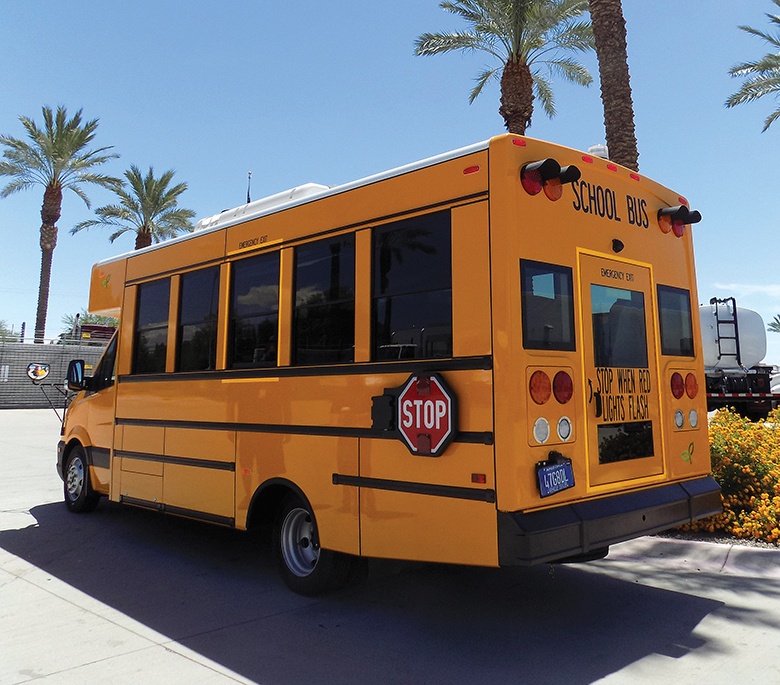
After the successful launch of the all-electric BEAST, GreenPower Motor Company is expanding its offerings with the company’s first Type A school bus – the Nano BEAST (Battery Electric Automotive School Transportation). Like its larger counterpart, 25-foot the Nano BEAST is the first commercially available, purpose-built, all-electric Type A school bus.
The Nano BEAST was developed using the EV Star – GreenPower’s purpose-built, zero-emission shuttle bus – as its foundation. The EV Star is a proven vehicle with more than 200 North American deliveries to date, and more than 700 assembled vehicles. While many school bus manufacturers build battery bus models on the same chassis as their equivalent diesel models, the Nano BEAST is factory-built as a zero-emissions school bus.
Engineering Makes a Difference
Seating up to 24 passengers (with optional an optional ADA lift by the rear curbside), the Nano BEAST’s 118KWh battery provides a range of up to 150 miles on a single charge (depending on driver and driving conditions), at speeds as high as 68 miles per hour. Its steel frame, aluminum body, and composite roof aid in ease of assembly, allowing GreenPower to pass those cost savings to its customers.
“This is the only vehicle using an all-aluminum Constellium body,” said Brendan Riley, president and director of GreenPower. This is a structural body, unlike other Type A buses that use welded metal hoops. The Nano BEAST body is fastened together with aluminum extrusions that make it very lightweight and extremely strong.”
“It’s a real, heavy-duty body,” he continued. “This is a full monocoque Type A school bus, which no one has ever built before using this configuration.”
The Nano BEAST completed full Altoona testing and is California Air Resources Board (CARB) and Buy America certified.
“This vehicle is well tested – the first Nano BEAST was delivered in 2018 and between Altoona testing and its certifications, the bus has a lot of time behind it,” Riley said. “With some vehicles having more than 20,000 miles in the field, this vehicle has real-world experience.”
Riley added that GreenPower has received all sorts of feedback – positive and negative – since the initial launch four years ago, and the company has incorporated every bit of useful information into the latest Nano BEAST models.
According to Riley, school districts can achieve up to a 70 percent reduction in operational savings – including fuel costs, fluid maintenance, oil changes, and transmission maintenance – by switching from diesel-fueled Type A buses to the Nano BEAST.
The battery system is ambient controlled, and a thermal management system keeps the batteries within a specific ambient temperature range that will increase battery life over time. The battery packs are placed within the superstructure, helping districts with walk-around inspections. Those battery pack locations also help the bus achieve a quieter and smoother ride.
“We use the same motor as the full-size BEAST,” Riley said. “Under the surface, the Nano BEAST has a very similar layout utilizing the same batteries. We use our iron phosphate, fire-safe, long-life power cells, which have proven super effective in our other models.”
Thanks to the Nano BEAST’s regenerative braking, pupil transportation providers can realize a 30 to 50-percent increase in overall brake life over competitive models. Furthermore, the brake regen can be configured to suit individual district’s needs via the vehicle’s advanced multiplexing system.
“Regen braking – really, the entire user experience – is totally fungible based on our customers’ needs,” Riley said. “The I/O Controls multiplexing system is programmable to fit any district’s specs. It’s a solid-state system that’s more reliable than relay logic, and I can change multiple functions of the bus with only a laptop.”
“On the physical side,” he said, “we can reconfigure lighting, AC controllers, dash buttons – really, any major feature can be modified to meet their needs.”
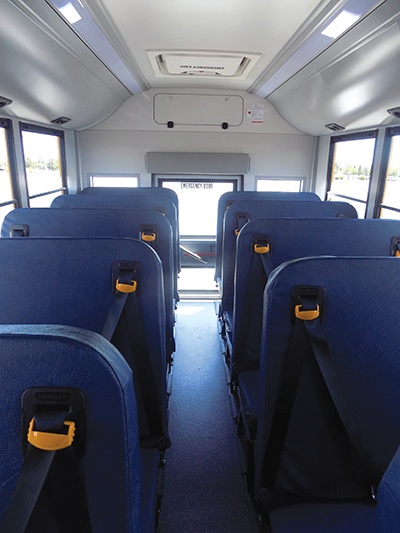 Test Driving the Nano BEAST
Test Driving the Nano BEAST
RWC Group is a major commercial truck and bus dealership and provides repairs, maintenance, body shop, and other services for its customers. RWC represents GreenPower in Arizona, Nevada, Washington, and Alaska, along with several other school bus manufacturers.
School BUSRide met with Brendan Riley of GreenPower at RWC Group’s Phoenix, Arizona, location, for an Official School BUSRide Road Test of the Nano BEAST with a licensed, third-party driver.
Tom Hartman, RWC Group‘s general manager – bus – has worked in the school bus industry for 28 years. He said that RWC’s primary business is in school buses and the dealer saw a void in the industry for all-electric Type D and Type A buses, which lead to the partnership with GreenPower.
“GreenPower’s expertise is 100 percent in electric propulsion – it’s what they do,” Hartman said. “The BEAST has the highest passenger capacity in an all-electric bus on the market, and our customers have been extremely happy with that vehicle.”
Hartman was eager to see the new Nano BEAST in person, as he has numerous district customers currently applying for EPA grants that, if awarded, will go toward purchasing GreenPower vehicles.
For the test drive, School BUSRideand RWC Group selected Chris Miller. Miller is a licensed driver and the lead mechanic at Saddle Mountain Unified School District (SMUSD) in Tonopah and Buckeye, Arizona.
The district, located west of Arizona’s White Tank Mountains, encompasses more than 500 square miles. It is one of Arizona’s largest school districts by area and is currently seeing an average annual population increase of 36 percent. Miller started working for SMUSD in 2013, and he estimated that student body has increased nearly fivefold in number.
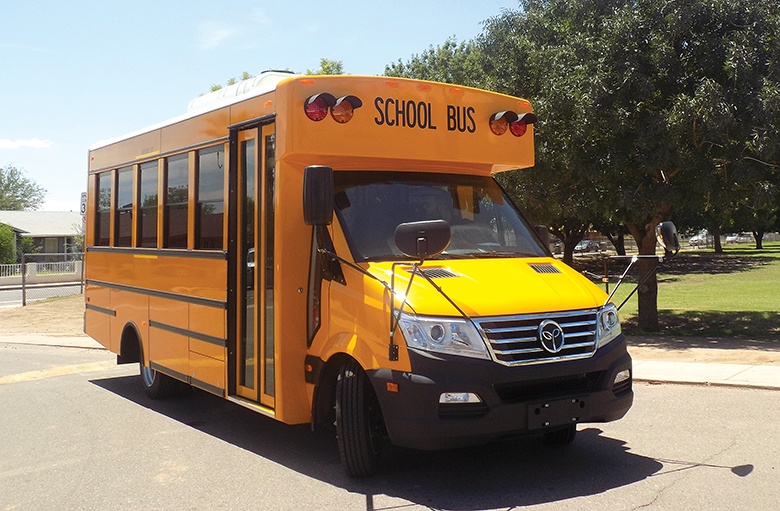
“Our longest route is probably about 136 miles, for one bus on its morning trip,” Miller said. Because of this, he was the perfect candidate to test out the Nano BEAST in Arizona’s demanding climate and conditions.
Upon entering the bus (along with Riley and School BUSRide’s editors), Miller observed that the driver’s dash/control area had a very modern, almost-automotive feel – but still stayed true to the classic school bus design.
“I first noticed that, compared to most school buses, the dash is fairly streamlined,” Miller said. “It’s ergonomic, and not too complicated. My first thought, when seeing this dash for the very first time, is ‘I can figure this out and start driving in less than a minute or two.’”
Miller worked through all the dash controls, including light indicators, door control, noise suppression, and driver- and passenger-air conditioning.
“I was very impressed with the air conditioning when the vehicle turned on,” he said. “Out on our routes, we use air conditioning a lot. The heat is always one of our biggest driver complaints.”
“The air-conditioner is an all-in-one unit, which is critical because the bus doesn’t have a motor to operate the compressor,” Riley said. “There are all sorts of inefficiencies created by having the bus pump refrigerant up into the A/C system, and we’ve gotten around them by using a high-voltage unit that runs off the batter.”
Riley added that floorboard and seat heaters are available for the Nano BEAST, although the unit in Arizona was not equipped (and had no need).
“Blowing heat uses a lot of power, and that can really have deleterious effects on electric vehicles (EV),” Riley said.
Riley said that the unit being tested in Arizona uses transit-grade heating and cooling. On an early-model EV districts might see up to 40 or 50 percent range reduction due to heating and venting, but the Nano BEAST typically only loses around 10 percent range when using all its /cooling functions and running at top speed. With heat, the Nano BEAST might see up to 30 percent range reduction.
“It’s important to remember that heat is the enemy of EVs,” Riley said. “But in this hot Arizona weather, the vehicle’s cooling system will hardly affect the range at all.”
Initially, Miller noted some blind spots around the vehicle’s “A” pillars, but conceded that his height (Miller is taller than 6 feet) may be a contributing factor. He was pleased with the mirror configuration in making up the difference, though.
Once the vehicle got rolling though, Miller praised the Nano BEAST’s drivability and noted that it felt much like a gas-powered automobile.
“When you start many electric vehicles, you sort of feel nothing, nothing, nothing, and then boom – it starts moving,” he said. “With this bus, it feels like the potentiometer is dialed in the way it should be, and the pickup is very familiar to anyone who has driven a car.”
Riley confirmed that GreenPower wants the Nano BEAST’s drivability to mimic a familiar acceleration for school bus drivers that might not have driven EVs before.
Miller noticed the vehicle’s adaptive braking right away, and Riley explained that the brake responsiveness can be fine-tuned based on the customer and district location.
To start the test, Miller drove the bus from RWC Group’s West Phoenix location into the Maryvale Village neighborhood approximately 3 miles to the north. There, he simulated the stop-start driving that a bus would normally see when picking up or dropping off students.
“I could definitely see this being an effective pre-K bus,” he said, as he pulled up to his first simulated stop. “It’s intuitive to turn on the hazards, start the warning functions, hit the brake, extend the stop-arm, and open the door.”
During a break in driving, Miller took time to inspect the interior of the Nano BEAST, commenting on the flooring and available space.
“When I first entered the bus, one of the first things I noticed was the floor,” Miller said. “It doesn’t seem like it will peel, which is a big issue with typical school bus flooring over time. I also noticed that the coloring is very welcoming for little kids to come in and sit – it’s not just a flay gray.”
Riley noted that, after conducting significant research on different materials, GreenPower equipped the Nano BEAST with high end, transit-style flooring manufactured by Altro Transflor. The vinyl floor “shines” thanks to crushed silicon, creating a non-slip surface. The flooring is also lightweight, fire safe, and lasts up to 10 times longer than standard rubber floors.
“Districts don’t always have the time or manpower to constantly wax or maintain their floors, and that only distracts from their main task of transporting kids safely,” Riley said. “This is the highest friction floor surface, preventing slips and falls while remaining easy to clean.”
The Nano BEAST’s floor is flat throughout the bus, which is a hallmark of all GreenPower vehicles. There are no wheel humps visible on the interior, and the floor has tracks allowing for seat and wheelchair reconfiguration. The flexibility is very important to GreenPower, as it maximizes accessibility and customizability for district customers.
“The lack of wheel humps is very helpful,” Miller commented. “When a seat rides up on a wheel hump, it can make the kid feel uncomfortable, and this eliminates those complaints.”
Exiting the Maryvale Village neighborhoods, Miller took the bus on a western route toward the closest highway – planning to test the Nano BEAST on the interstate on a northern route toward Glendale, Arizona.
On his normal route for SMUSD, Miller typically sees about 50 miles of freeway twice per day. He would not normally drive a Type A bus on that route, but he wanted to feel the vehicle’s pick-up as it entered highway driving.
“You can feel the power getting on the freeway, which is nice,” he said. “You wouldn’t do a lot of highway driving with this type of bus, but it can certainly handle the speed.”
Upon entering Glendale, Miller drove the bus to a parking lot near State Farm Stadium (home of the Arizona Cardinals football team). There, he completed some tight turning, cornering, and figure-eight maneuvers.
Miller was impressed with the vehicle’s lower center of gravity and how it affected the Nano BEAST’s handling.
“It does not seem as top heavy as other buses of a similar size,” he said. “You get used to it, and it seems to be the same or a little bit better than a gas-powered bus in that area. The center of gravity is set up very well with this bus.”
Ultimately, Miller concluded that the Nano BEAST would have no problem handling a normal Phoenix route.
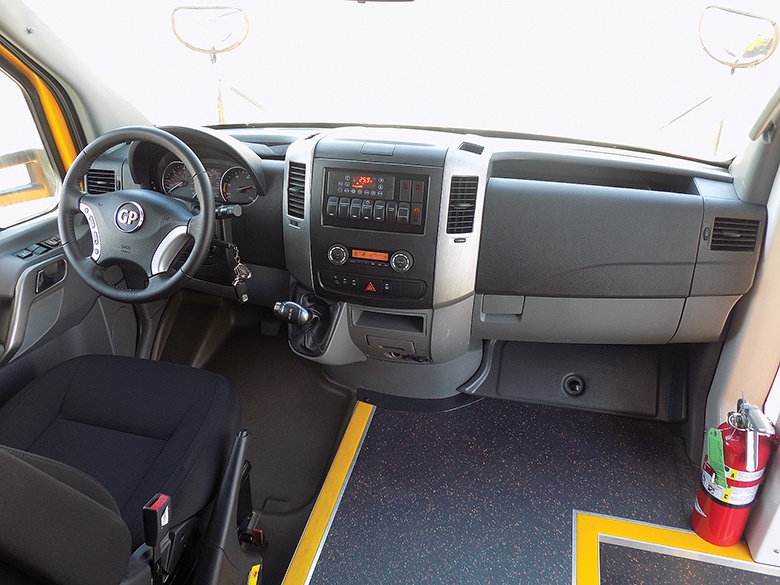
Nano BEAST: Ready for Deployment
After returning to the RWC Group facility in Phoenix, Miller and Riley took some time to discuss the vehicle’s maintenance. As the lead mechanic for SMUSD, Miller was particularly interested in this element of the Nano BEAST.
“Just from looking at the bus, I can tell that the designers have worked on buses and trucks before,” he said. “When I was exploring the bus, I really took note of the many removable panels. It seems like genius in terms of serviceability, because you don’t need to disassemble large parts of the bus to do maintenance on a small, specific area.”
Riley noted that the dash can be configured to show mechanics all the vehicle’s vitals – from battery voltages, to potential motor faults, and any other potential errors.
“The dash can give you all the same information that you might get from a scan tool, and we can set the controls to only be accessed by technicians,” Riley said. “It’s all built-in, and that’s an advantage we have because the bus is purpose-built.”
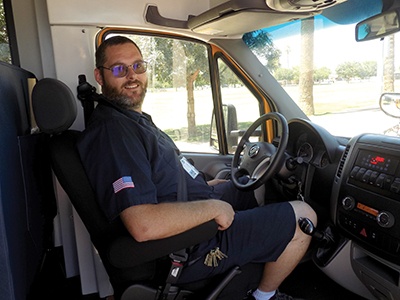 “I love that,” Miller said. “From a technical standpoint, I don’t necessarily need to run and grab my laptop – I can get most of the data I need from this display.”
“I love that,” Miller said. “From a technical standpoint, I don’t necessarily need to run and grab my laptop – I can get most of the data I need from this display.”
Riley concluded that the vehicle, which has already started delivering, will largely be available to districts via federal funding, grants, and the recently-passed infrastructure bill.
“Schools will mostly be obtaining the Nano BEAST at no cost to themselves,” he said. “Furthermore, by the time production really starts rolling on this vehicle, we expect that it will be less expensive than its internal combustion engine equivalent.”
“Our goal is to replace all Type A applications, anywhere, with the Nano BEAST,” Riley added, “especially if the route has a lot of stops, and the range and payload match the vehicle’s profile. It will make a big impact in any district with idle emissions, as well as disadvantaged communities and non-attainment areas.”
Miller’s closing comments focused on the Nano BEAST’s modern style and appeal, something he said is much needed in school bus design.
“The drive is great, but even something as simple as the internal lighting – it has a real modern, sleek, 21st century feel,” he said. “It seems that some buses haven’t changed much since I was a kid and riding them to school. This bus feels like a really modern update, without compromising the integrity of the yellow bus.”


